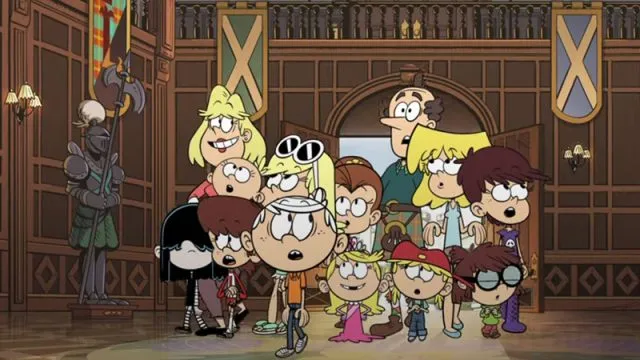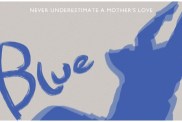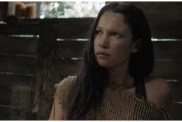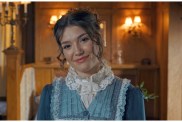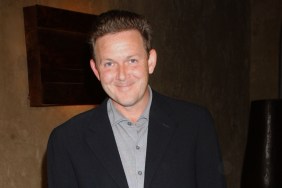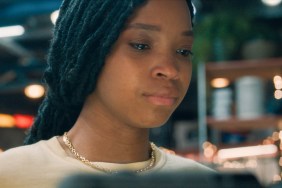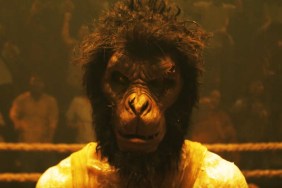The Loud House Movie, based on the popular animated series, is currently streaming on Netflix and marks the directorial debut of Dave Needham who previously worked in various roles on films such as Trolls, Penguins of Madagascar, The Boss Baby, The Lego Batman Movie, and Smallfoot.
ComingSoon’s Jeff Ames spoke with Needham about The Loud House Movie, what drew him to animation, working with Jamie Hewlett on Gorillaz, and working with David Tennant and Michelle Gomez on the new feature.
RELATED: The Loud House Movie Trailer Previews the Family’s Royal Vacation
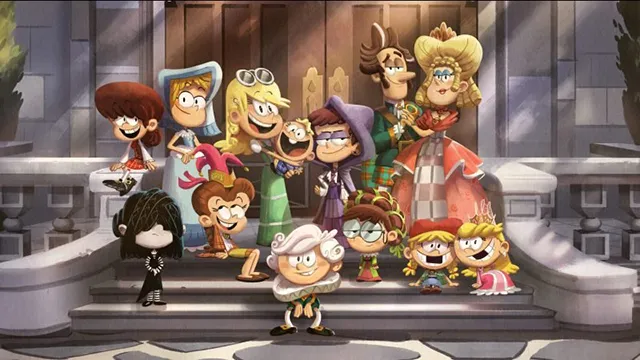
Jeff Ames: What ultimately drew you to the animation scene?
Dave Needham: It’s about telling stories. When I was a little kid, I look used to love drawing and I used to love making comics. All through my childhood and teens, I would print my own comics and it all grew from there. When I was at university, I self-published a comic with some friends and sent it out to other comic creators whose work I really admired. I got a reply from Bill Wray, a background artist who worked on Ren and Stimpy — he was also a regular contributor to Mad Magazine at the time — and he had this viewpoint of both comics and animation, and said something along the lines of, “Yeah, you know, you could draw comics and you’d spend the rest of your stuck inside your bedroom. Or, you could work in animation where you work in a group and basically spend the whole day making each other laugh!” I was like, “Oh, I choose that one! That sounds more fun to me.”
So, the penny really dropped, and I was on a course then to try and break into animation. This is over 20 years ago now. I wanted to move to the United States straight away after talking to Bill and come over to California in the late 90s, but the reality was making that leap in one go was too much.
I ended up moving to London and working on animation in some of the smaller commercial studios down there. One way or another, I found myself working on a secret project that no one knew about and it was called Gorillaz, and it was pretty amazing because Blur is one of my favorite bands and Jamie Hewlett was one of my favorite artists. I got to work in Jamie’s studio — just me, him and two other people — before anyone knew what Gorillaz was. I had a stack of his sketchbooks on my desk and we played video games every lunchtime. It was kind of amazing!
When it came out, you know, we had sat on one of the coolest projects in London for the last six months. It was amazing to see the reaction of the first videos when they came out. That was cool.
So, yeah, I started off working more as a designer. I used to have a bit of a skill in trying to ape other people’s styles, which is how I ended up working on Gorillaz. Jamie needed help designing backgrounds and other things while he was working on the characters. I was working on the website and other stuff. And then, one way or another, I became an art director. I worked in Paris for a bit on Robotboy with Charlie bean. That was an amazing experience, getting the chance to work in another country and everything. Then I worked in the development studio Cartoon Network had in Soho in London for a few years, and that was great too, because we all had a chance to make our own pilots, but we got a chance to work with some of the big directors like Pete Candeland, who had directed the Gorillaz videos.
One of the things that came out of [this experience] was Gumball. So, I had the chance to work on Gumball and that was great. Developing that with Ben Bocquelet — that show is basically him. He is Gumball and it’s his real sister’s name and his real dad. It’s all him.
He’s not actually a blue cat, but everything else applies. But I designed Banana Joe for that. It is basically a banana with some googly eyes stuck on it. I don’t know if it still has blue lips, but it did in the first season. The reason for that is I just photographed a banana with googly eyes and stuck some blue tack, which you used to stick posters on the wall, which just happens to be that light blue color. I had photographed him and drew some arms and legs on it and was like, “Hey, that looks pretty good!” That was cool.
Then, about 10 years ago, I moved to the states because I had always wanted to, and I’d put it on hold and had been enjoying myself living in London and Paris and everything, but it felt like time for a change. I got a chance to come over here and I quite quickly ended up working at DreamWorks up in Redwood City on Penguins of Madagascar as a board artist with Derek Drymon as my head of story. He’s someone that I knew a little bit from London — he’d come over and stuff — and that was cool. I was being asked on a daily basis to do things I’d never done before and you just had to sit there and go, “Well, they hired me to do this … I better figure it out!” It was a different style of boarding to TV boarding. I’d done, you know, boarding a little bit of TV shows, but this was suddenly like, “Have the camera follow the penguins as they jump off the edge of the building and have it tip into a sort of straight down shot as they fall and their parachutes open.” Like, “All right, I guess.” I’ve got to learn to think like a camera, like a moving camera. That was a big difference for me, and then getting all that choice — you know, it’s one thing to say it, and it’s another thing to actually draw it! What you learn is you’re making all these choices all the time about where the camera is and what that implies and stuff. But I loved learning it.
So, I moved down to LA and I worked on Boss Baby with Tom McGrath and he was the person that taught me so much. Because every time he came in the room, he’d say something smart and I’d write it down. He’d be like, “Either move the camera or move the characters, but don’t move both because then you’ll never see anything!” Stuff like that.
I loved working on Boss Baby because there was a great board team on it, and we were all pushing ourselves to be funnier than the last person. So, you’d be really pushing yourself to come up with stuff. We stuck to the script by and large, but you got a chance to plus it and add your own lines, and it was really cool to see that Tom embraced that. You’d actually see some of your lines in the final movie and then Alec Baldwin is saying them. It was really cool.
Actually, I did a voice back then in 2014 that was just used in Boss Baby 2 — Glue Baby. So, I enjoyed working at DreamWorks and having those chances on movies like Trolls — it was really fun.
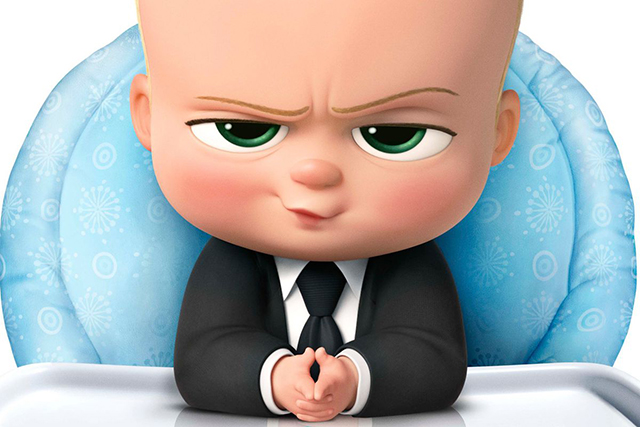
So, now you’ve jumped into the director’s chair with The Loud House…
Yeah, that’s right. I moved through the gears a little bit. I was head of story on Smallfoot at Warner Bros., so I had had the chance to be head of the story team. And that way you ended up working a lot more closely with editorial. I actually managed to get my editor for the movie, Peter Ettinger; and he was the editor of Smallfoot as well, so he and I had worked together a little bit. Ramsey Naito is the head of Nickelodeon Animation and she was a producer on Boss Baby. So, she was the person who reached out to me and said, “Hey, I’m at Nickelodeon now. Can we start making some movies? How would you like to direct something?” I was like, “You know the answer to that question.”
So, I was really excited to come over and — going right back to the beginning of the story and Bill Wray — Nickelodeon was a door that I knocked on 22 years ago in 1998, and it was my first chance coming back to the studio and actually working here, which was kind of amazing. As was working with the guys from The Loud House series — Mike Rubiner, the showrunner, and Kevin Sullivan who wrote the first few drafts of the movie and is also the head writer on the show. They were really generous with embracing my ideas for the movie. And my ideas basically were to do a lot of small things that would add up to something that would elevate it above the series and make it a more cinematic experience.
Specifically, the first act does feel a little bit more like the show. We’ve got a big opening sequence and then it settles into the world of Royal Woods. Everyone gets caught up with who the family is and who the characters are and stuff like that, but when they go to Scotland in the second act, the camera’s sort of changed a little bit. There’s more depth, there’s more space and it becomes more dimensional and that’s very deliberate to make it feel like they were a little closed in at their house in the first act. Then, later on, there’s just all this room to run around and breathe and explore a whole new world as we got into it.
So, speaking on that, Loud House the TV show is 2D animation. Did you feel limited by that?
Occasionally, but I try not to limit the board teams’ thinking on that. Our board team had a nice blend of a couple of people from the series and about three or four people from the feature world. And that was great because they could inspire each other and learn from each other. If the feature artists who hadn’t worked on the show before wanted to say, “Hey, which system would do this?” or, “Is this joke too weird for Loud House?” they could check in with the board artists that had been working on the show for several years.
Then you’d also get the most cinematic sort of staging, which it’s simple things like placing the camera behind — Loud House normally is very flat. It’s very left to right, like watching a play on a stage. We were placing the camera down with the characters and behind the character. So, it was a chance to go more cinematic with a camera, but without changing too much about the characters. In fact, the character rigs are almost exactly the same as the series. What we did do was allow them to move in Z space towards and away from the camera and place the camera in new places. It did leave one or two challenges for the animation team. Occasionally — I can’t think of any off the top of my head — but we may have had to rethink the odd shots or two to just make it a little bit more sympathetic to 2D animation.
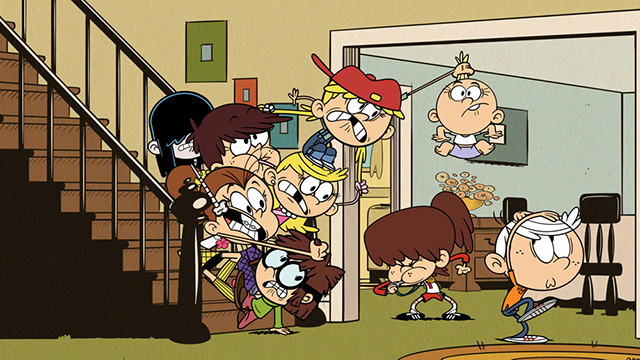
You’ve got a great ensemble cast to work with — David Tennant, Michelle Gomez, Billy Boyd, among others. How much direction do you need to give to really get the performances you’re looking for with this type of talent?
Well, for one thing, the main cast is huge. We have a voice director for the cast, Lisa Schaffer. I sat in with her on some episodes of the series just to see how she managed a big room like that. With the main cast, we decided the best thing to do was to let Lisa keep going. I would whisper in her ear if I needed to, but nine times out of 10, she’d have my note and she’d give it without even needing to check in with me. So, the main cast just kind of took care of itself. They were very dialed in.
Then, of course, recording Michelle Gomez and David Tennant happened after we went into lockdown. So, we had some pretty rough recordings to start with where they didn’t have the proper mix. We got it all dialed in after the first recording but started with people who were literally recording into their iPhones just so we had some scratch to work with. They were often in more intimate settings than you would normally find them. You know, it might be remote to another recording studio somewhere, but this was, “I’m in David Tennant’s bedroom and he’s made a little tent fort at the bottom of his bed with blankets so that he can mockup a little recording studio.” It was the same with all of those guys in those early days. But everyone pulled together. Everyone was really generous with how much they were willing to be part of the team.
They record it locally and then upload it, and that’s not normally something you’d ask David Tennant to do, but he was like, “Okay, I’ve got it recorded. It’s downloading now. It’ll take 30 minutes. I’ll check if you want me to. If it doesn’t work, let me know and I’ll re-upload it.” He just became like one of the team. Obviously, it changed over time. It went from being in people’s bedrooms to eventually, when it was safe to do so, getting them into recording studios and doing the full records with them. But it was quite a deal. It felt relatively easy to get them into their characters. We would experiment with it for the first half an hour or hour, but telling David, for example — he’s playing a character who’s soft-spoken and he’s kind and willing and wanting to show he’s the host. He wants to show the Louds around the town. It’s like, “Well, yeah, that’s not too far from who he is anyway.”
Michelle Gomez is awesome at playing villain characters and she’s got some meaty scenes to really get her teeth into. I don’t know if you know this, but Loud House is a musical as well. So, they all got songs. David has a song. Michelle Gomez has a song. Asher Bishop has a couple of songs as Lincoln. And they all did incredibly well. In fact, David, even before we had the song written, asked, “When do I get to sing?”
It was a delight to work with them all. The other two with slightly smaller parts were Billy Boyd. He plays a character that’s not been on any of the trailers yet. So, I don’t talk too much about him. Obviously, they’re all Scottish and they’re playing Scottish characters. So, you know, they don’t have to do an accent or anything like that. And Katy Townsend rounded out the cast. She plays Lucille, who’s the ghost equivalent of Lucy. And she was great. She spent a lot of time studying Lucy’s cadence, you know, how Lucy talks and the deadpan nature of it, you know? So, she would have a similar voice, but different obviously to Lucy’s.
With something like this that takes so long to make, how do you keep the material fresh in your eyes? Because, I would imagine, there’s a tendency to think the jokes aren’t working after hearing them for the hundredth time, right?
Yeah, but that’s true of all movies. In fact, this movie just took over two years to make, from start to finish which is like light speed for an animated film. Penguins probably took about four years to finish, and those jokes sometimes do start to feel stale. But what you have to remember is how hard people laughed the first time they heard them because you can’t laugh at the same joke after the 30th time. But it’s always great to have fresh eyes, that’s why screenings are important. Our first screening was before lockdown and we had it in the screening room here at Nick. Our editor would often record the whole thing to hear what jokes people laughed at and things like that, so we’d be able to remember. He’d always remind me, “People find that funny! I know right now you’ve heard it 38 times in a row and it’s sounding a little stale, but we just have to remind ourselves what we thought the first time we heard the joke.” I guess it’s like being a marathon runner as opposed to a sprinter. You just compose yourself a little differently.
But those screenings are important. That’s when you get people with fresh eyes. We would have some screenings. We always got really positive notes from the people at Netflix, but when they did give a note it would often be like, “Oh, that’s really, wow. Why didn’t we think of that?” Katie Mullins was the exec over at Netflix who would deliver the notes. And I remember one in particular where she said — without getting too many spoilers, because we do have a villain in this movie. Maybe I shouldn’t talk about this because it’s not come out yet… But her note was really good. She basically said, “What does Morag’s victory look like?” We didn’t have that moment for the character. We were like, “Oh, of course! Morag just wants peace and quiet this whole time.” When you first see her, she’s actually in a bubble bath in the castle. So, we just put her back in a bubble bath and she’s like, “Finally.” That’s what her victory looked like. That was a good note.
RELATED: DreamWorks’ TrollsTopia Season 4 Trailer Invites You to Make Some Noise
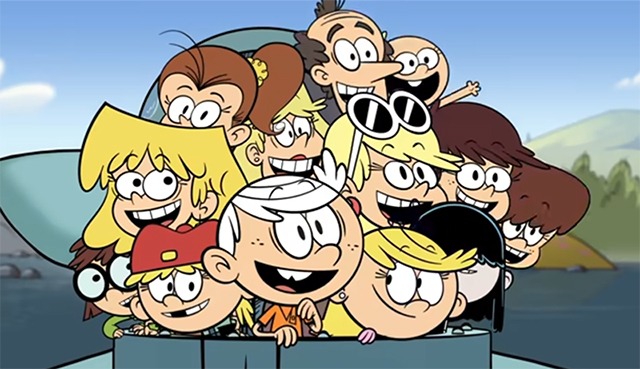
What are you most excited for fans of the series to see in the film?
I’m really excited for the fans of this series to see everything in this film, but what they’re going to see — what I hope they’re going to see — is that they start seeing a familiar place and it takes its time to grow and move through the gears and see a new world for the characters. By the end of the movie a whole new experience, a lot of action, a lot of comedy; and hopefully it should still feel like hanging out with your friends. I hope it’s a more cinematic experience for the fans.
There are lots of Easter eggs in the movie that the people making this — I’m new to it — but Kevin and, and Mike have been with the show since it started along with a couple board artists. So, they’d be the ones to go, “Oh, you know, we did this back then!” They would make sure we stayed on a path that was true to the series. We managed to pay off one or two little things. Like, you’d never seen Lucy’s eyes. In the opening sequence, you see her from the back as a baby and she looks bald and she turns to the camera, but of course, she’s already got bags.
There’s lots of little things like that throughout the movie which are little nods to existing fans, but one of my main goals was to not be exclusive to existing fans. I wanted to allow new fans to come to Loud House and be able to get who the family is and enjoy them just like the existing fans out there watching our adventures.
